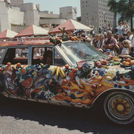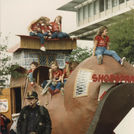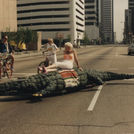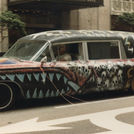OF THE HOUSTON ART CAR PARADE
HISTORY

HOUSTON ARTIST JACKIE HARRIS TRANSFORMED THE CAR INTO A MOBILE WORK OF ART WITH A BUDGET OF $800 FOR PAINT AND PLASTIC FRUIT
In 1984, Kit and Carl Detering donated a 1967 Ford station wagon to The Orange Show Foundation to be auctioned at our annual Gala benefit. Houston artist Jackie Harris transformed the car into a mobile work of art with a budget of $800 for paint and plastic fruit. The "Fruitmobile" was donated back to the foundation by the group of six who purchased it. Also in 1984, Ann Harithas curated an exhibition called "Collision" at Lawndale Art Center that featured two art cars. All this activity resulted in a number of art cars seen on Houston streets. In 1986, Rachel Hecker and Trish Herrera organized a New Music Parade in conjunction with the New Music America Festival. Some 20 artist floats and art cars paraded down Montrose Boulevard, ending at the dedication of the MFAH sculpture garden. A few months later, Susanne Demchak organized a "Road Show" at The Orange Show on June 29, 1986, 11 art cars were exhibited alongside the Fruitmobile at The Orange Show, with Lowrider demonstrations, and children's art bike workshops. 1,400 Houstonians came, along with WFAA-TV and National Public Radio.

ROADSIDE ATTRACTIONS: THE ART CAR PARADE WAS BORN IN APRIL 1988 WITH A 40 CAR PARADE SEEN BY AN ESTIMATED 2,000
In 1987, the Houston International Festival, the City's official celebration of the arts, asked the Orange Show to organize a parade to build on the success of the New Music Parade. The Orange Show agreed to produce an event dedicated to art cars. Roadside Attractions: The Art Car Parade was born in April, 1988 with a 40 car parade seen by an estimated 2,000. By the following year, the parade size doubled and the crowd swelled to tens of thousands. Another important milestone came in 1989, when Harrod Blank came from California with his art car, "Oh My God." On a quest to document America's art cars that eventually led to his two books and two films on art cars, Harrod told artists all over the nation about the Houston Art Car Parade, and soon we began to see caravans of art cars travel thousands of miles to be in the parade. Another major milestone was the entry of Rebecca Bass and Edison Middle School in 1990. "The Body Shop" went on to win major awards, and started educators across the city to see art car projects as tools to teach life skills and engage students with their schools and community.
THE ART CAR PARADE TODAY
Today, the Houston Art Car Parade is the highlight of a four-day celebration of the drive to create, Houston Art Car Parade Weekend.
-
The parade attracts 250+ vehicles and other entries from 23 states along with Canada and Mexico
-
A live audience of some 250,000+ spectators
-
Parade entries include anything on wheels from bicycles and unicycles to lawnmowers to cars and go-carts
-
Entries are as likely to be made by members of the general public as by recognized artists
Community groups, public and private schools, and professional organizations have become regular participants. Inspired by what they see, spectators create art cars of their own and often become future participants. And as the parade grows, attracting more and more participants, the complexity and quality of the entries increases.
Photos from the 1988 and 1989 Houston Art Car Parades - the first two years
LEADING THE PARADE EACH YEAR
ART CAR GRAND MARSHALS
2024 - BROCK WAGNER, Founder & Brewer of Saint Arnold Brewing Company
2023 - MARILYN OSHMAN, Founder of the Orange Show Center for Visionary Art
2022 - BUN B, Rapper, Philanthropist, Restaurateur
2019 - RAUL BRINDÍS, Spanish Radio Host
2018 - JEANNETTE EPPS, American Astronaut
2017 - CHEECH MARIN, Author, Comedian, Art Collector
2015 - ANNISE PARKER, Former Houston Mayor
2014 - ANNISE PARKER, Former Houston Mayor
2013 - GERTRUDE BARNSTONE, JOHN ALEXANDER, THE ART GUYS, Houston Artists
2012 - J.J. WATT & CONNOR BARWIN, Houston Texans Football Players
2011 - LYNN WYATT, Philanthropist
2010 - DAN AYKROYD, Actor
2007 - GEORGE CLINTON, Musician

Brock Wagner
2024 Grand Marshal
ART CAR HONOREES
REPRESENTING HOUSTON'S CULTURAL LEADERS
Started as a new annual tradition in 2023, the Orange Show Center for Visionary Art recognizes the important contributions to Houston's cultural identity made by three individuals - an artist, an educator, and a patron.

2025 Artist
Jesse Sifuentes
An apprentice of world-famous muralist Dr. John Biggers, Jesse Sifuentes has established himself as one of the East End’s preeminent artists. During his 30 years as an East End resident, Sifuentes has created scores of public works and collaborated with countless partners to contribute to the area’s rich visual history. He currently teaches art at Texas Southern University. He has amassed an impressive collection of public works on the walls of businesses throughout the neighborhoods. Sifuentes works in both paint and mosaic tile, creating murals that speak to the life and history of the community within which he works. Several years ago, Sifuentes collaborated with East End artists and students from Austin High School
2025 Educator
Julon Pinkston
Julon Pinkston is an artist and art educator based in Houston, TX, currently teaching at Waltrip High School. Since 2015, he has led art car youth groups to success, earning several accolades in the Houston Art Car Parade and in Trinidad, CO. With a passion for mixed media sculpture and painting, his work has been exhibited in numerous galleries and museums, including the Art Car Museum and Ro2 Gallery in Dallas. Pinkston began his artistic career after serving as an Infantry soldier in the US Army. He holds a Bachelor of Fine Arts from the University of Houston and a Master of Fine Arts from the University of North Texas. Through his teaching and artistic practice, he continues to inspire creativity and innovation in the classroom and beyond.


2025 Patron & Orange Show Board Member
Will Robinson
Thomas Pascal Will Robinson is an entrepreneur, longtime advocate for the art car movement, designer and artist. Growing up in the Houston and New York art world, he was mentored by Jesse Lott, Mel Chin, David Best, Larry Fuente, and Jim Harithas. He worked alongside his father, Tom Robinson, at Robinson Galleries and later co-owned Pascal Robinson Galleries, promoting Latin and North American art.
A lifelong car fanatic, he has restored numerous vehicles, with one featured in the Ann Harithas Collection of Art Cars. He has served on the Orange Show Center for Visionary Art board for over a decade, attending its events since the foundation’s early days. As a judge for the Art Car Parade for 14 years and a benefactor of the Art Car Museum, he has played a prominent role in preserving and expanding Houston’s visionary art scene.
He studied at the Glassell and Instituto Allende and worked at the Boca Raton Museum of Fine Art. While living in San Miguel de Allende, he founded the town’s first motorcycle tour business, restored cars, built café racer motorcycles, and restored the Embarcadero.
For his dedication to historic preservation, he received the Preservation Houston Society’s Good Brick Award for restoring his home in the Westmoreland Historic District of Montrose. With a lifelong passion for art and automobiles, he continues to push creative boundaries and support the arts.
HIGHLIGHTING EXCELLENCE IN ARTISTY AND DESIGN
ART CAR PARADE WINNERS
Over $15,000 is awarded annually to Art Cars in various categories, showcasing the best in creativity, execution, performance, and artistic achievement.

2024 Ann Harithas Legacy Award Winner
"The Ploppet" by Claire & Kyle Johnson
Scottsdale, AZ
ART CAR MANIFESTO
BY JAMES HARITHAS
The history of the privately owned vehicle is fundamental to this century. The art car is a revolutionary extension of this history and is in the process of transforming the automobile into a potent new personal symbol. An art car is a motor-driven vehicle which a car artist alters in such a way as to suit his own aesthetic. In other words, the artist either adds or subtracts materials of his own choosing to or from the factory model or he may renovate an earlier model to revive a beauty and style that once was. The result is a vehicle which conveys new meaning through design, mechanical or structural changes, renovation, and/or the addition of new images, symbols or collage elements.
The content and meaning of these changes vary with each art car and may express either political, social, personal or purely decorative objectives. All art cars are subversive and have in common the transformation of the vehicle from a factory-made commodity into a personal statement or expression.
The art car is revolutionary in the sense that it reclaims the vehicle for the individual and proclaims an independence and diversity which is in sharp contrast to the increasingly conventional and impersonal automobiles and trucks which are currently being produced. More often than not, the art car has an earthiness, a witty or exotic appearance which the new computer designed factory models lack. On one level, art cars can be seen as a popular movement engaged in rescuing the automobile from corporate uniformity. In so doing, art cars are reviving the sense of individuality which is in decline in our society. On another level, the art car represents the degree to which minorities, subcultures and modern artists continue to influence the cultural life of the United States.
The art car phenomenon is recent, appearing roughly in the last fifteen years. However, the impulse to decorate one’s automobile or truck stretches back in time and crosses continents. Consider the vehicles in the Philippines, Cuba, Mexico or Pakistan whose colorful decoration often invokes the protection of the Virgin or the gods. The art car concept in the United States is fundamentally secular, although religious subject matter is sometimes used, and derives a significant part of its inspiration from hot-rods, racers, classics, Jesus buses, low-riders and hippie vans.
The low-rider and the hippie van provide the art car with its most inspiring precedents. Each in its own was one of the first to express a revived sense of individuality and to create vehicles which are metaphors of political and economic dissent. The low-rider is a Mexican-American innovation which not only communicates a sense of pride in Mexican culture but also exhibits the astonishing mechanical skills of the owners. Engines powerfully reconstructed and hydraulic innovations are engineering feats which, along with their spectacularly painted images, transform each of these vehicles into something more than a popular artifact. In other words, low-riders communicate the cultural vitality of the barrio and at the same time, express personal ingenuity and artistry. They symbolize the transformation of the car owner into an artist/warrior for his people.
Hippie vans were much in evidence during the 1960s and early 1970s. They were garish but courageous expressions of dissent which exposed the car owners to real dangers on the highway from police and rednecks. The hippie van is characterized by its graffiti approach to decoration, its use of peace and anti-war symbols and its independent spirit. As such, its influence on the art car is readily apparent.
Another major influence on the art car is the modern tradition in art. Modern art in its end-of-the-century manifestation, so-called postmodern art, is distinguished by its accessibility to artists and non artists alike. It is an art which emphasizes personal expression and a choice of imagery or subject matter selected from popular culture. The postmodern is also an approach in which considerations of style and high art are minimized in favor of anti-art, gender, ethnicity, kitch, popular or recycled commercial or historical imagery. It may be enough to say that art cars reflect the variety of styles of late modernism, even though the majority of the artists are unschooled in art.
The art car artist is pioneering a new image of the automobile, an image which in its diversity reflects fundamental changes in popular consciousness, changes based on the desire for greater independence and individual rights. Ever since early 20th century innovations in production-line manufacturing made it widely accessible, the automobile has become an intrinsic part of everyday life. On a practical level, it has become an indispensible extension of the home and the work place.
From its origins to roughly 1975, American automobiles dominated the world market. Each brand had its own symbolism, for example, a Caddie or a Lincoln represented power and wealth, a Chevy or a Ford, rugged individualism. Car owners identified with their vehicles to the extent that they often fell in love with them and the love which was felt was more than one of possession or status. Automobiles were extensions of our sense of self. The freedom which the automobile represented then was not simply practical or one of convenience, but also involved democratic ideas of upward mobility and freedom of movement.
Today car owners feel differently about their vehicles and personal freedom is more of a myth or an ideology than it was. Most accept that the automobile is little more than a necessity in a society which has become increasingly conformist and seems bent on the accumulation of wealth irrespective of ecological, social and personal destruction. The reputation of the automobile has been tarnished and its status as an icon diminished. The space ship has replaced the automobile as our primary symbol of mobility and national strength and for most people, driving an automobile is no longer the adventure and the deep source of pride that it once was. The automobile has become implicated in the decline of air quality in our cities because of its dependence on fossil fuels. Accidents, smog, gridlock, DWI laws, car payments, car insurance and the cost of gasoline and repairs have weakened our sense of freedom of the open road. In addition, we now have little propriety interest in American-made vehicles with the good reason that they no longer reflect who we are.
The art car movement is part of the growing attempt to renew our commitment to ourselves by reducing the control that the government and the corporations have over us. At the same time, it is on the cutting edge of a significant change in popular consciousness because it implies a transfer of power to the individual.
Get into the left lane and aim high, but keep one eye on the rear view mirror for the black and whites. Art cars are a grass roots movement. Change your vehicle, improve it, personalize it and make your own statement with it so that you can once again become one with it. Art cars are an expression of your freedom and above all, of the God-given American right to be yourself and flaunt it on the highways and byways of America.
Reprinted from Art Cars – Revolutionary Movement, published by The Ineri Foundation, 1997.



























